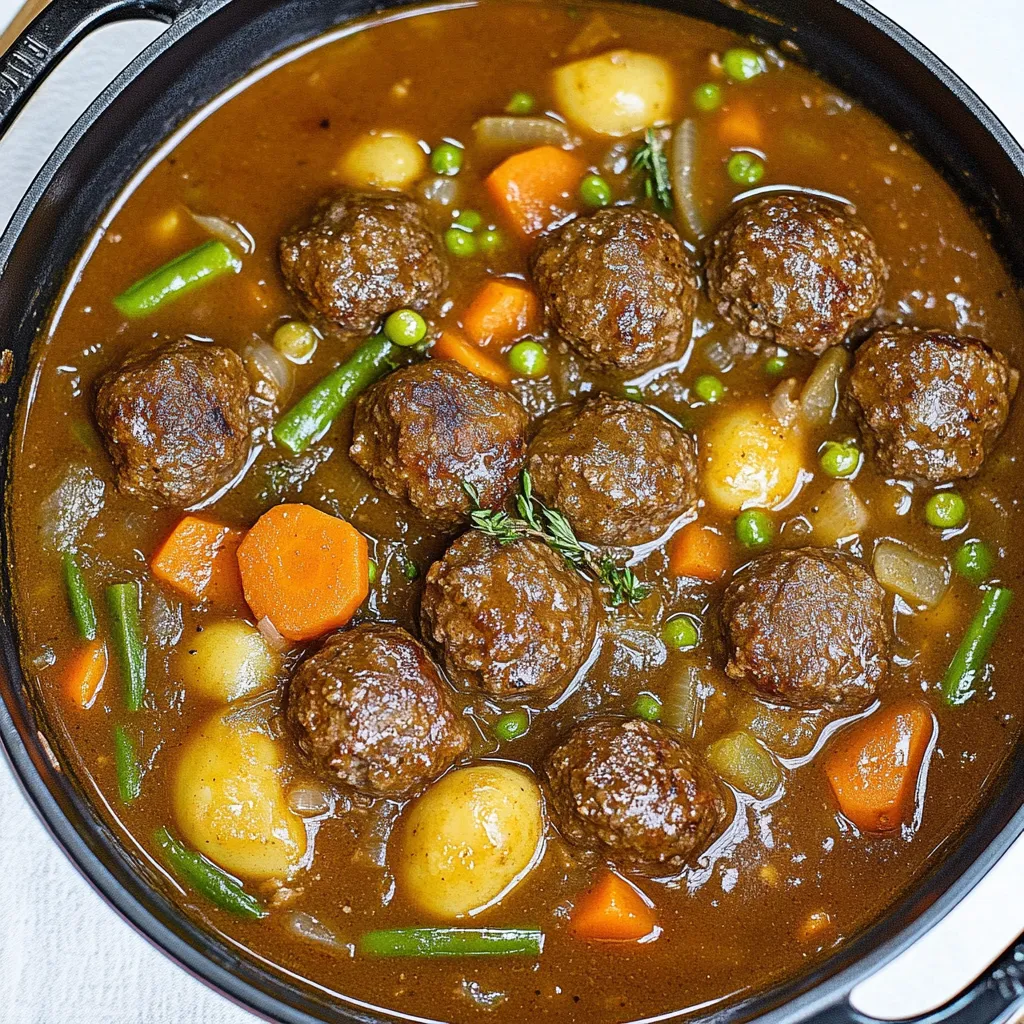 Pin it
Pin it
This rustic meatball stew marries two comfort food classics into one soul-warming masterpiece that's destined to become your family's cold-weather favorite. Tender, seasoned meatballs simmer alongside hearty vegetables in a rich, savory broth that develops extraordinary depth of flavor as it cooks. The beauty of this versatile one-pot wonder is that it works perfectly on the stovetop, in a slow cooker, or even in your Instant Pot—making it the ideal recipe for busy weeknights or lazy weekend cooking. As the days grow shorter and temperatures drop, there's nothing quite like a steaming bowl of this hearty stew to bring everyone running to the dinner table.
I stumbled upon this recipe during one particularly brutal winter when my family was craving something beyond our usual soup rotation. The first time I served it, my husband—typically reserved with his food compliments—took one bite and declared it an instant family classic. My son, who normally pushes vegetables around his plate, actually asked for seconds, carefully selecting meatballs and then surprisingly coming back for more vegetables too. Since then, it's become our go-to Sunday dinner through fall and winter, filling the house with mouthwatering aromas that create an atmosphere no scented candle could ever match.
Essential Ingredients
- Ground Beef: Forms the foundation of tender, flavorful meatballs that hold their shape while simmering. The ideal fat content is 80/20, which provides enough fat to keep the meatballs juicy without making the stew greasy. The slight marbling creates meatballs that remain tender even after extended cooking.
- Breadcrumbs: Act as a binding agent that helps meatballs maintain integrity during cooking. Plain, unseasoned varieties work best as they allow you to control the flavor profile. They also absorb moisture from the meat, keeping the meatballs light rather than dense.
- Potatoes: Provide hearty substance and natural thickening to the stew. Waxy varieties like Yukon Gold or red potatoes maintain their shape beautifully during long simmering, offering distinct pieces rather than disintegrating. Their buttery texture creates perfect contrast to the meatballs.
- Red Wine: Introduces complex acidity and depth that transforms an ordinary stew into something special. Its tannins and fruit notes create layers of flavor impossible to achieve with broth alone. Choose a dry variety you'd enjoy drinking—cooking concentrates flavors rather than eliminating them.
- Beef Broth: Creates the savory liquid foundation that unifies all components. Quality matters significantly here; a good broth provides richness and umami notes that elevate the entire dish. Better Than Bouillon paste offers exceptional flavor concentration for homemade quality without the effort.
- Fresh Herbs: Infuse the stew with aromatic complexity that dried varieties simply cannot match. Fresh thyme and rosemary release their essential oils slowly during cooking, perfuming the entire dish with their distinctive flavors that complement both the beef and vegetables perfectly.
Step-by-Step Cooking Instructions
- Craft perfectly seasoned meatballs -
- In a large mixing bowl, combine 1 pound ground beef (80/20 blend), ⅓ cup plain breadcrumbs, 1 beaten egg, 1 finely diced small onion, 2 minced garlic cloves, 1 teaspoon salt, and ½ teaspoon black pepper. Using clean hands, gently mix the ingredients just until combined, being careful not to overwork the meat, which would result in tough meatballs. Form the mixture into 20-25 uniformly sized balls, approximately 1½ inches in diameter. For best results, chill the formed meatballs in the refrigerator for 15-20 minutes to help them maintain their shape during browning.
- Develop rich meatball flavor through browning -
- Heat 2 tablespoons olive oil in a large Dutch oven or heavy-bottomed pot over medium-high heat until shimmering. Working in batches to avoid crowding, carefully add meatballs to the hot oil, leaving space between each one. Cook for approximately 2 minutes per side, turning gently with a spoon, until they develop a deep brown crust on multiple sides. They should not be cooked through at this stage—just beautifully browned on the exterior. Transfer the browned meatballs to a paper towel-lined plate and set aside. This browning process creates the foundation of flavor for the entire stew through the Maillard reaction.
- Create your aromatic vegetable base -
- Reduce heat to medium and add another tablespoon of olive oil if the pot appears dry. Add 1 diced medium onion, 2 sliced carrots, 2 diced celery stalks, and 8 ounces sliced mushrooms to the pot. Sauté in the flavorful oil and meatball drippings for 5-7 minutes, stirring occasionally, until the vegetables begin to soften and the onions become translucent. Add 3 minced garlic cloves and 2 tablespoons all-purpose flour, stirring constantly for one minute until the flour coats the vegetables and loses its raw smell. The flour will ultimately help thicken the stew to the perfect consistency.
- Deglaze to capture concentrated flavors -
- Pour ¾ cup dry red wine into the pot, using a wooden spoon to scrape up all the browned bits from the bottom—these contain concentrated flavor compounds that will enrich your stew. Add 2 tablespoons tomato paste and stir to incorporate it fully with the wine and vegetables. Allow this mixture to simmer for 4-5 minutes until slightly reduced and intensified. The alcohol will cook off while leaving behind the wine's complex flavor profile.
- Build your stew's liquid foundation -
- Add 4 cups beef broth, 2 sprigs fresh thyme, 1 sprig fresh rosemary, and 1 bay leaf to the pot. Stir to combine, then carefully return the browned meatballs to the simmering liquid. Bring the mixture to a gentle boil, then reduce heat to maintain a steady simmer. Allow everything to cook together for 15-20 minutes, uncovered, so the flavors can begin to meld while the meatballs finish cooking through.
- Incorporate hearty vegetables in stages -
- Add 1 pound of waxy potatoes, cut into 1-inch chunks, to the simmering stew. Continue cooking for 25 minutes, or until the potatoes are just fork-tender but still hold their shape. Next, add 1 cup fresh or frozen green beans (cut into 1-inch pieces) and ½ cup fresh or frozen peas. Simmer for a final 5-7 minutes until the green vegetables are tender but still vibrant. This staged addition ensures each vegetable is perfectly cooked rather than some being mushy while others remain undercooked.
- Perfect your stew's final flavor profile -
- Remove the pot from heat and discard the herb sprigs and bay leaf. Allow the stew to rest for 5-10 minutes off the heat; this crucial resting period allows flavors to marry while the stew thickens slightly to its ideal consistency. Taste and adjust seasoning with additional salt and freshly ground black pepper as needed. If desired, garnish with fresh chopped parsley just before serving for a bright color contrast and fresh flavor note that balances the rich stew.
 Pin it
Pin it
The Meatball Miracle
The beauty of meatballs in stew versus traditional stew meat lies in their perfectly tender texture and flavor concentration. While stew meat can sometimes become stringy or dry despite long cooking, meatballs remain juicy and tender by design. The breadcrumbs and egg act as insurance against toughness, while the spherical shape allows even cooking from all sides.
My grandmother always insisted that meat should be handled with a light touch. "You're not kneading bread," she would say as she gently mixed her meatball mixture. This wisdom proves particularly important for stew meatballs, which need to remain tender despite prolonged cooking. Over-mixing activates proteins that tighten during cooking, creating tough results.
I discovered through trial and error that chilling the formed meatballs before browning makes a remarkable difference in their final texture. This simple step allows the fat to firm up and the proteins to relax, resulting in meatballs that hold their shape perfectly while developing a beautiful exterior crust that seals in moisture.
The first time I made this recipe for friends during a weekend cabin getaway, everyone was intrigued by the concept of meatball stew. After the first few bites, conversation stopped completely as everyone focused on their bowls. By the end of the meal, they were already discussing which cooking method they'd use when making it at home.
The Secret Life of Potatoes
Potato selection might seem like a minor detail, but it significantly impacts your stew's final texture. The distinction between waxy and starchy potatoes becomes crucial during the long simmering process of stew-making.
Waxy varieties like Yukon Gold and red potatoes contain less starch and more moisture, allowing them to maintain their shape and texture even after extended cooking. Their firmer cell structure means they won't dissolve into the broth, instead providing distinct, tender bites throughout the stew.
My first attempt at this recipe used russet potatoes, which quickly broke down and thickened the stew to an almost gravy-like consistency. While still delicious, it wasn't the texture I was aiming for. Switching to Yukon Golds created the perfect balance—the potatoes remained intact while still releasing enough starch to give the broth body.
When I teach cooking classes, I often use this stew to demonstrate how the same ingredient can function differently depending on the variety chosen. Students are always amazed at how such a seemingly small decision can transform the entire eating experience.
I had an unexpected revelation when making this stew during a power outage using only my gas stovetop. Without electricity for my usual kitchen distractions, I focused entirely on the cooking process and noticed how the liquid gradually transformed—becoming more unified and glossy as it simmered. This observation led me to extend the simmering time slightly in future batches, resulting in noticeably more complex flavor. Sometimes limitation leads to the best discoveries.
After countless iterations of this recipe, I've found that the quality of your beef broth makes a dramatic difference in the final flavor. When time allows, I make a quick enhanced broth by roasting beef bones for an hour before simmering them with aromatics. When shortcuts are necessary, I doctor store-bought broth by simmering it with mushroom stems, a splash of soy sauce, and a spoonful of tomato paste before using it in the stew. These small touches elevate the entire dish without significant extra effort.
This meatball stew has become more than just a recipe in our household—it's a tradition that signals the changing seasons and brings everyone together around the table. There's something magical about a dish that satisfies both sophisticated palates and picky eaters, that works as well for casual family dinners as it does for entertaining guests. In a world of trendy food fads, this hearty, honest stew reminds us why some classics never go out of style.
Frequently Asked Questions
- → Can I make this meatball stew ahead of time?
- Yes! This stew actually tastes better the next day. Store in the refrigerator for 3-4 days or freeze for up to 3 months.
- → What can I use instead of red wine?
- You can substitute additional beef broth or use grape juice with a tablespoon of vinegar to add acidity.
- → Can I use frozen meatballs?
- Yes, pre-made frozen meatballs work great in this recipe. Just add them directly to the stew and simmer until heated through.
- → What kind of potatoes work best?
- Waxy potatoes like Yukon gold or red potatoes hold their shape better. If using russet potatoes, reduce cooking time to prevent them from falling apart.
- → Can I make this in a slow cooker?
- Yes, brown the meatballs first, then combine all ingredients in a slow cooker and cook on low for 5-6 hours or high for 2-3 hours.
